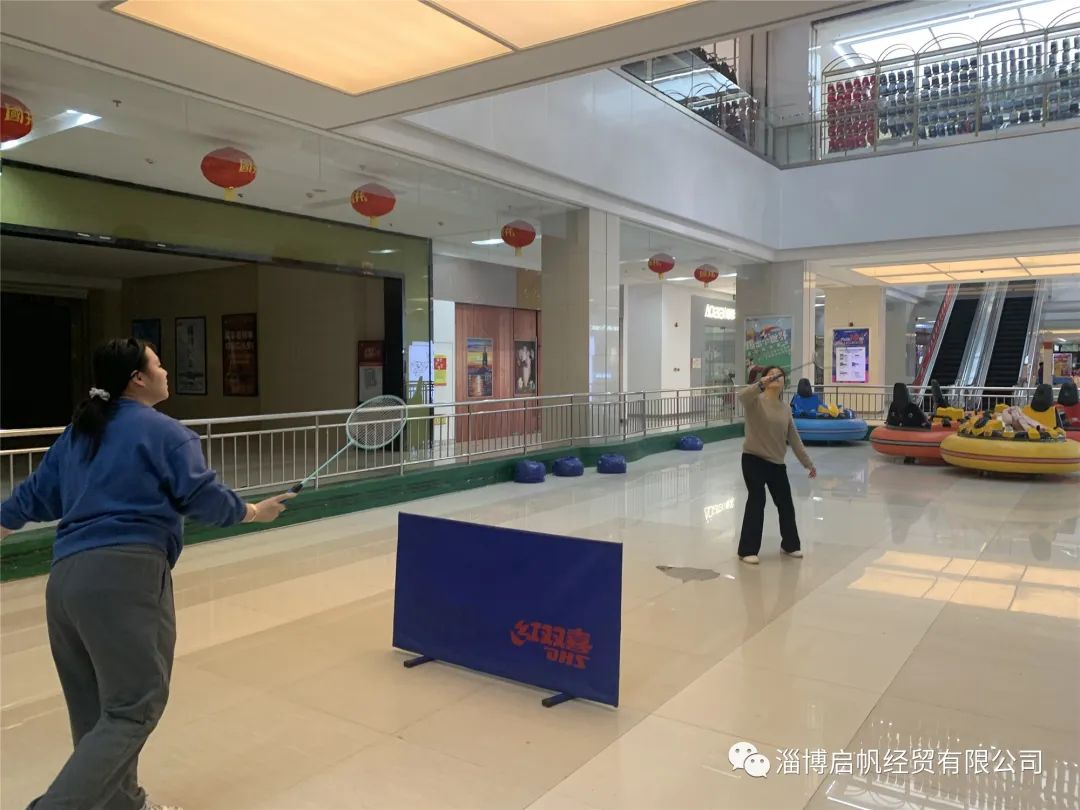
The weather was getting cold, in order to enhance everyone's physique, Zibo Qifan Activity Department organized a badminton activity to strengthen the staff's muscles and bones and improve their immunity.

Benefits of winter sports:
First, in modern society, the pace of life and work is very fast, and the human body is in a state of overload for a long time. As the saying goes: "life lies in sports", proper sports have a good effect on promoting human health, and winter sports can also exercise people's willpower.
Two, in winter, the temperature is low, the air is relatively clean (except for the haze weather in the north), the respiratory tract is comfortable, and it can promote the blood circulation of the whole body. More naturally increases the amount of exercise and accelerates the amount of calories consumed. If the summer exercise is vigorous sweat like rain, the winter exercise advantage is quietly bring weight loss effect.
Three, winter sports to choose the action range is small, the heat consumption of aerobic exercise. This is because the winter climate is cold, explosive anaerobic exercise easily cause physical discomfort. Specific programs vary according to age.
Four, young people can choose to run and other high intensity aerobic exercise, which can consume more calories, exercise time should be more than spring and summer 10 to 15 minutes. In terms of exercise timing, young people's fitness can be arranged in the morning and afternoon in winter due to their strong ability to adapt to the climate, good physique and quick physical recovery.

Here are 9 more winter exercises for you
1. Jump rope. When the weather is too cold for other outdoor activities, jumping rope is a good choice. It has a good effect on heart function, keeps the cardiovascular system strong and healthy, and reduces the risk of respiratory disease.
Tip: Before jumping rope to exercise the whole body, jumping rope speed should be from slow to fast, step by step. The knee should be slightly bent when jumping, skipping no less than 4 times a week, but preferably no more than 6 times, each skipping time controlled at about 30 minutes.
2. Go jogging. Jogging has a good effect on maintaining good heart function, preventing heart function decline, preventing muscle atrophy, preventing coronary heart disease, hypertension, arteriosclerosis, obesity and so on.
Tips: Jog to maintain an even speed, do not feel uncomfortable subjectively, objectively controlled at the heart rate per minute 180 minus the number of age is appropriate. For example, a 60-year-old person should jog at a heart rate of 180-60-120 beats per minute and exercise for at least 20 minutes, not less than four times a week.
3. Take the stairs. Studies show that walking 200 steps a day five times a week for eight weeks improves heart and lung function by 18 percent and reduces bad cholesterol by 8 percent. Run two flights of stairs every day, can lose 4 to 5 jin a year; Running up the stairs can burn up to 500 calories in an hour.
Tips: On the stairs should pay attention to the use of thigh muscles, hip muscles and abdominal muscle strength, to avoid damaging the knee, when feeling tired, you can use the stair handrail to help lift the body up, to reduce the burden on the thigh, but also exercise the arm muscles.
4. Tai Chi. The metabolism of the human body is relatively slow in winter, so we should pay attention to the spiritual defense in exercise to avoid the leakage of Yin, Jing and Yang. Taijiquan helps regulate breath and qi, dredge meridians and collaterals, and harmonize Qi and blood.
Tip: Stay warm from the cold. Taijiquan is a sport that seems to have little physical activity, but actually it is very tiring in the body. Strengthen the preparation activities before exercise. The flexibility of the body decreases in winter. Only with adequate preparation can sports injuries be prevented.
5. Alternate between running and walking. There are two methods: one is walk before run, that is, walk for 1 minute and run for 1 minute, alternating. The other is to start by walking, as the body's ability to adapt to improve, gradually transition to jogging instead of walking.
Tips: Walking and running should choose safe and smooth roads, suitable shoes and socks; Keep the recommended amount of brisk walking at 1 hour a day, and run for about half an hour.
6. Badminton. Playing badminton in winter is very convenient, only need a piece of open space and the ball can be, badminton on the physical fitness of the exercise is very comprehensive, it needs the eyes, brain, hands, feet, shoulders, waist, arms and legs of the comprehensive coordination of action.
Tip: Warm up before you play and keep your joints open. After playing, you should pay attention to relax and tidy up after coming down from the court. Do several groups of muscle stretching exercises, which are conducive to body recovery.
7. Swim. Swimming is an excellent exercise that exercises muscles all over the body. Underwater exercise not only increases blood flow to the brain and improves vascular health.
Tip: Always bring slippers to avoid catching cold on the soles of your feet; Bring bath towels or towel-cloths to keep you warm after a break or shower. In the middle of the rest, after the water to put on a bath towel, dry hair, wear good clothes, to prevent cold.
8. Ride a bike. Cycling in winter can improve blood circulation and immunity. Continuous exercise can also help keep you warm and improve your heart and lung function. In addition to help lower limb muscle strength, coordination, balance ability to improve.
Tips: To master the time, generally should be controlled in 1 hour or so, secondly, to adjust the handle and seat height, and pay attention to maintain the correct posture. Finally, when stepping on the pedal, the position of the foot should be appropriate, the force should be even, and the attention should be paid to maintain a certain rhythm.
9. Take a walk. Walking is the most highly recommended form of exercise by medical and exercise experts. Walking can enhance cardiovascular function, promote blood circulation, prevent heart disease, lower blood pressure. In addition, it can promote lung function, aid digestion, reduce weight, relieve mental tension and regulate immune function.
Tip: You should walk within your capacity. The standard amount of exercise is a little sweat. Secondly, pay attention to walking posture, to raise the chest, slightly pull in the abdomen and buttocks, relax the shoulders, the arm naturally droop, swing back and forth.

- Call on everyone not to forget to exercise in winter.
This Article Records 1 Page



